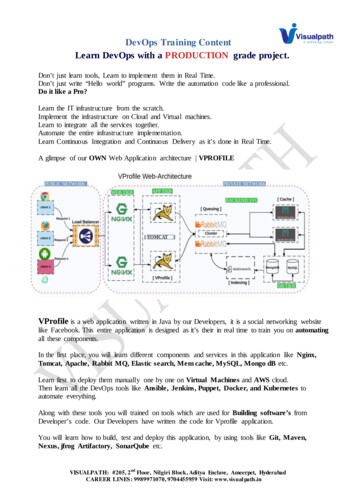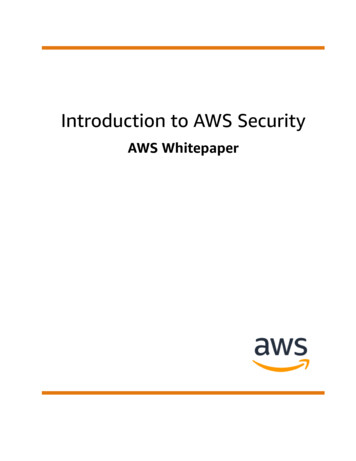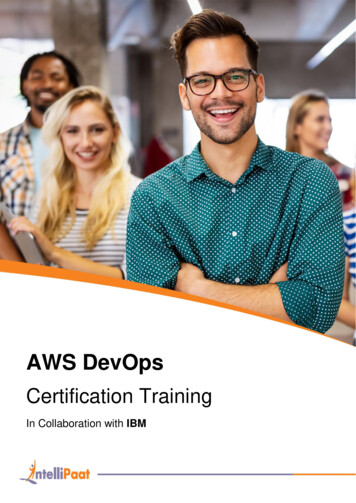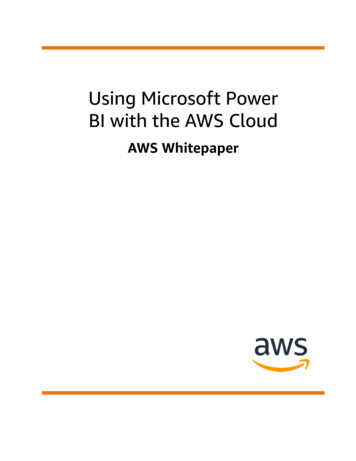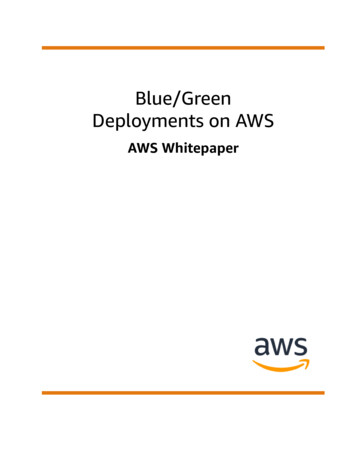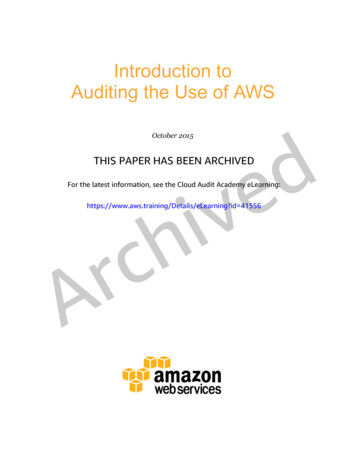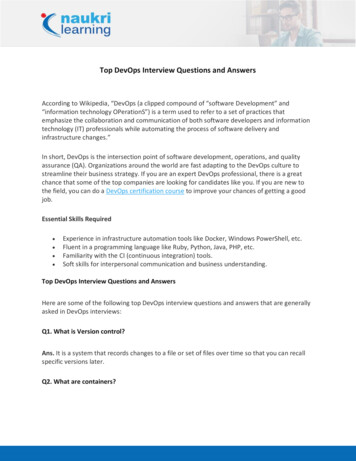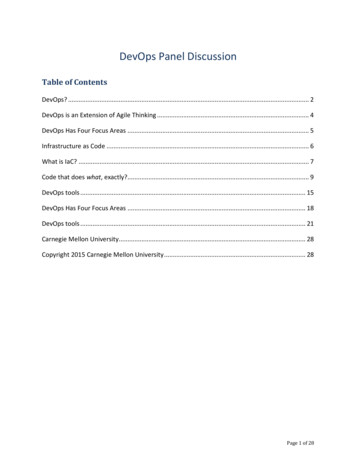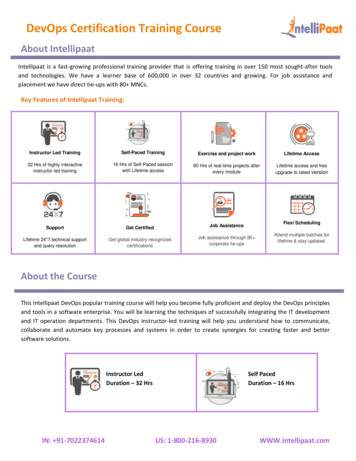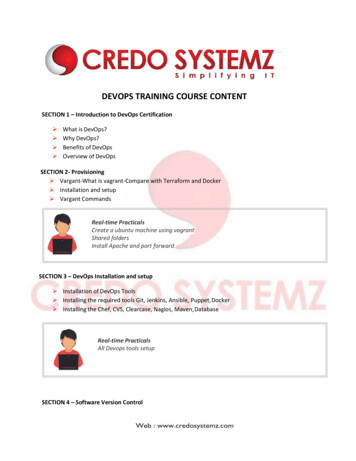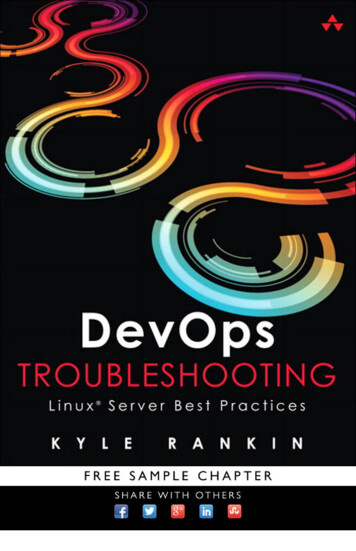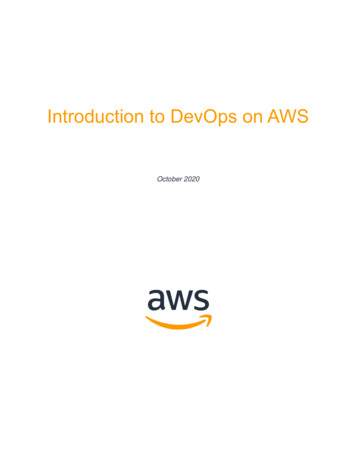
Transcription
Introduction to DevOps on AWSOctober 2020
NoticesCustomers are responsible for making their own independent assessment of theinformation in this document. This document: (a) is for informational purposes only, (b)represents current AWS product offerings and practices, which are subject to changewithout notice, and (c) does not create any commitments or assurances from AWS andits affiliates, suppliers or licensors. AWS products or services are provided “as is”without warranties, representations, or conditions of any kind, whether express orimplied. The responsibilities and liabilities of AWS to its customers are controlled byAWS agreements, and this document is not part of, nor does it modify, any agreementbetween AWS and its customers. 2020 Amazon Web Services, Inc. or its affiliates. All rights reserved.
ContentsIntroduction .1Continuous Integration .2AWS CodeCommit .2AWS CodeBuild.3AWS CodeArtifact .3Continuous Delivery .4AWS CodeDeploy .4AWS CodePipeline .5Deployment Strategies .6Blue-Green Deployments.7Canary Deployments.7Linear Deployments .7All-at-once Deployments .7Deployment Strategies Matrix .7AWS Elastic Beanstalk Deployment Strategies .8Infrastructure as Code .9AWS CloudFormation .10AWS Cloud Development Kit .12AWS Cloud Development Kit for Kubernetes.12Automation .12AWS OpsWorks .13AWS Elastic Beanstalk.14Monitoring and Logging .15Amazon CloudWatch Metrics .15Amazon CloudWatch Alarms .15Amazon CloudWatch Logs .15
Amazon CloudWatch Logs Insights.16Amazon CloudWatch Events .16Amazon EventBridge .16AWS CloudTrail .17Communication and Collaboration .18Two-Pizza Teams.18Security .19AWS Shared Responsibility Model .19Identity Access Management.20Conclusion .21Contributors .21Document Revisions.22
AbstractToday more than ever, enterprises are embarking on their digital transformation journeyto build deeper connections with their customers to achieve sustainable and enduringbusiness value. Organizations of all shapes and sizes are disrupting their competitorsand entering new markets by innovating more quickly than ever before. For theseorganizations, it is important to focus on innovation and software disruption, making itcritical to streamline their software delivery. Organizations that shorten their time fromidea to production making speed and agility a priority could be tomorrow's disruptors.While there are several factors to consider in becoming the next digital disruptor, thiswhitepaper focuses on DevOps, and the services and features in the AWS platform thatwill help increase an organization's ability to deliver applications and services at a highvelocity.
Amazon Web ServicesIntroduction to DevOps on AWSIntroductionDevOps is the combination of cultural, engineering practices and patterns, and toolsthat increase an organization's ability to deliver applications and services at highvelocity and better quality. Over time several essential practices have emerged whenadopting DevOps: Continuous Integration, Continuous Delivery, Infrastructure as Code,and Monitoring and Logging.This paper highlights AWS capabilities that help you accelerate your DevOps journey,and how AWS services can help remove the undifferentiated heavy lifting associatedwith DevOps adaptation. We also highlight how to build a continuous integration anddelivery capability without managing servers or build nodes, and how to leverageInfrastructure as Code to provision and manage your cloud resources in a consistentand repeatable manner. Continuous Integration: is a software development practice where developersregularly merge their code changes into a central repository, after whichautomated builds and tests are run. Continuous Delivery: is a software development practice where code changesare automatically built, tested, and prepared for a release to production. Infrastructure as Code: is a practice in which infrastructure is provisioned andmanaged using code and software development techniques, such as versioncontrol, and continuous integration. Monitoring and Logging: enables organizations to see how application andinfrastructure performance impacts the experience of their product’s end user. Communication and Collaboration: practices are established to bring theteams closer and by building workflows and distributing the responsibilities forDevOps. Security: should be a cross cutting concern. Your continuous integration andcontinuous delivery (CI/CD) pipelines and related services should besafeguarded and proper access control permissions should be setup.An examination of each of these principles reveals a close connection to the offeringsavailable from Amazon Web Services (AWS).1
Amazon Web ServicesIntroduction to DevOps on AWSContinuous IntegrationContinuous Integration (CI) is a software development practice where developersregularly merge their code changes into a central code repository, after whichautomated builds and tests are run. CI helps find and address bugs quicker, improvesoftware quality, and reduce the time it takes to validate and release new softwareupdates.AWS offers the following three services for continuous integration:AWS CodeCommitAWS CodeCommit is a secure, highly scalable, managed source control service thathosts private git repositories. CodeCommit eliminates the need for you to operate yourown source control system and there is no hardware to provision and scale or softwareto install, configure, and operate. You can use CodeCommit to store anything from codeto binaries, and it supports the standard functionality of Git, allowing it to workseamlessly with your existing Git-based tools. Your team can also use CodeCommit’sonline code tools to browse, edit, and collaborate on projects. AWS CodeCommit hasseveral benefits:Collaboration - AWS CodeCommit is designed for collaborative software development.You can easily commit, branch, and merge your code enabling you to easily maintaincontrol of your team’s projects. CodeCommit also supports pull requests, which providea mechanism to request code reviews and discuss code with collaborators.Encryption - You can transfer your files to and from AWS CodeCommit using HTTPSor SSH, as you prefer. Your repositories are also automatically encrypted at restthrough AWS Key Management Service (AWS KMS) using customer-specific keys.Access Control - AWS CodeCommit uses AWS Identity and Access Management(IAM) to control and monitor who can access your data as well as how, when, andwhere they can access it. CodeCommit also helps you monitor your repositories throughAWS CloudTrail and Amazon CloudWatch.High Availability and Durability - AWS CodeCommit stores your repositories inAmazon Simple Storage Service (Amazon S3) and Amazon DynamoDB. Yourencrypted data is redundantly stored across multiple facilities. This architectureincreases the availability and durability of your repository data.2
Amazon Web ServicesIntroduction to DevOps on AWSNotifications and Custom Scripts - You can now receive notifications for eventsimpacting your repositories. Notifications will come in the form of Amazon SimpleNotification Service (Amazon SNS) notifications. Each notification will include a statusmessage as well as a link to the resources whose event generated that notification.Additionally, using AWS CodeCommit repository triggers, you can send notificationsand create HTTP webhooks with Amazon SNS or invoke AWS Lambda functions inresponse to the repository events you choose.AWS CodeBuildAWS CodeBuild is a fully managed continuous integration service that compiles sourcecode, runs tests, and produces software packages that are ready to deploy. You don’tneed to provision, manage, and scale your own build servers. CodeBuild can use eitherof GitHub, GitHub Enterprise, BitBucket, AWS CodeCommit, or Amazon S3 as a sourceprovider.CodeBuild scales continuously and can processes multiple builds concurrently.CodeBuild offers various pre-configured environments for various version of Windowsand Linux. Customers can also bring their customized build environments as dockercontainers. CodeBuild also integrates with open source tools such as Jenkins andSpinnaker.CodeBuild can also create reports for unit, functional or integration tests. These reportsprovide a visual view of how many tests cases were executed and how many passed orfailed. The build process can also be executed inside an Amazon Virtual Private Cloud(Amazon VPC) which can be helpful if your integration services or databases aredeployed inside a VPC.With AWS CodeBuild, your build artifacts are encrypted with customer-specific keys thatare managed by the KMS. CodeBuild is integrated with IAM, so you can assign userspecific permissions to your build projects.AWS CodeArtifactAWS CodeArtifact is a fully managed artifact repository service that can be used byorganizations securely store, publish, and share software packages used in theirsoftware development process. CodeArtifact can be configured to automatically fetchsoftware packages and dependencies from public artifact repositories so developershave access to the latest versions.3
Amazon Web ServicesIntroduction to DevOps on AWSSoftware development teams are increasingly relying on open-source packages toperform common tasks in their application package. It has now become critical for thesoftware development teams to maintain control on a particular version of the opensource software is vulnerability free. With CodeArtifact you can set up controls toenforce the above.CodeArtifact works with commonly used package managers and build tools like Maven,Gradle, npm, yarn, twine, and pip, making it easy to integrate into existing developmentworkflows.Continuous DeliveryContinuous delivery is a software development practice where code changes areautomatically prepared for a release to production. A pillar of modern applicationdevelopment, continuous delivery expands upon continuous integration by deploying allcode changes to a testing environment and/or a production environment after the buildstage. When properly implemented, developers will always have a deployment-readybuild artifact that has passed through a standardized test process.Continuous delivery lets developers automate testing beyo
DevOps is the combination of cultural, engineering practices and patterns, and tools that increase an organization's ability to deliver applications and services at high velocity and better quality. Over time several essential practices have emerged when adopting DevOps: Continuous Integration, Continuous Delivery, Infrastructure as Code, and Monitoring and Logging. This paper highlights AWS .
